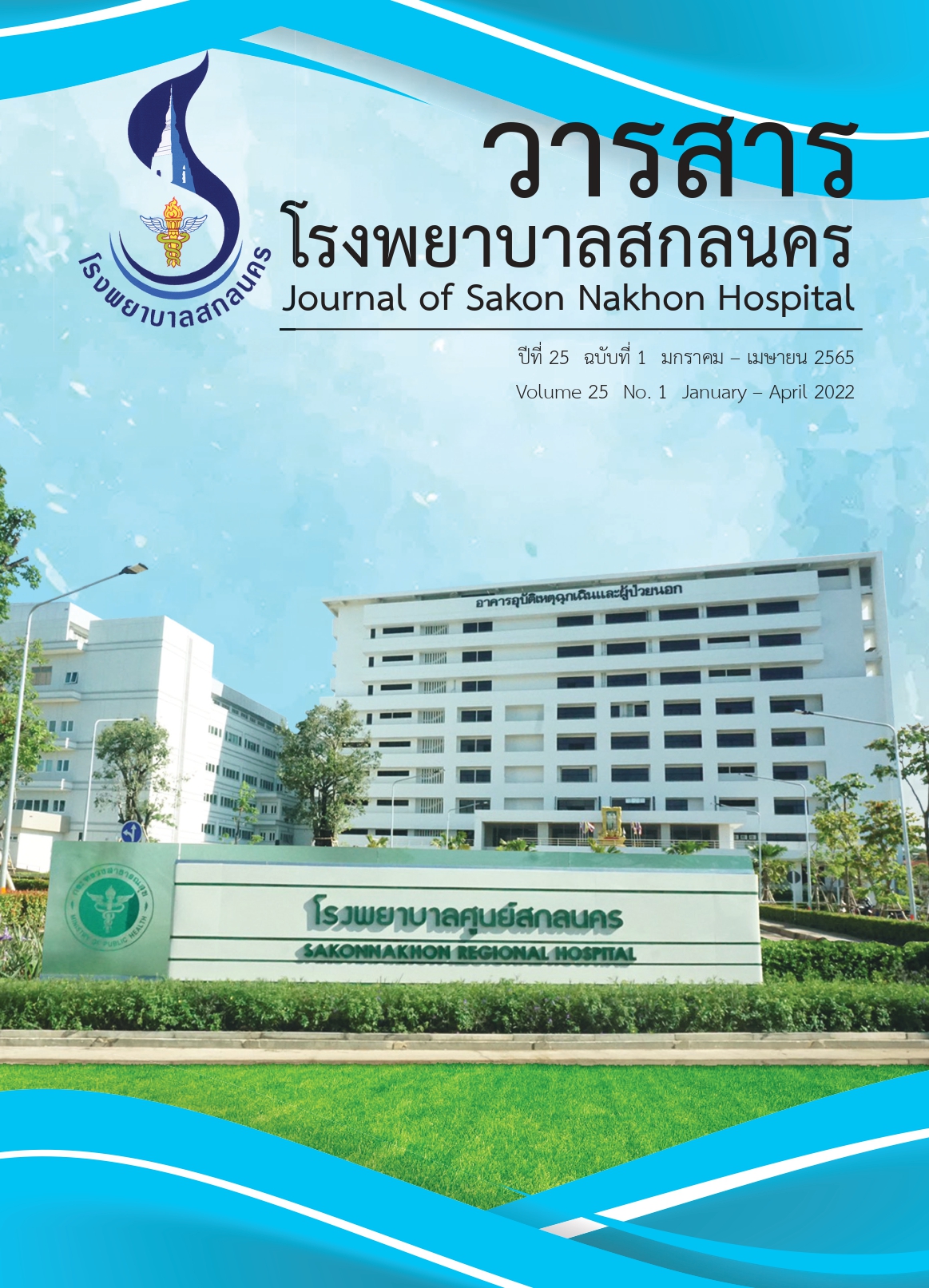Factors Predicting Anemia in the Cancer Patients Receiving Chemotherapy: A Systematic Review
Keywords:
Factors predicting anemia, Cancer patients receivingAbstract
The incidence of chemotherapy–induced anemia (CIA) is up to 60–90 percent. Anemia resulted in a decrease in patient’s quality of life and poor prognosis. This review aimed to synthesize the knowledge about predictive factors of anemia in cancer patients receiving chemotherapy. The empirical evidence–based conclusion could lead to the development of nursing guidelines in cancer patient care. This systematic review searched for both local and international research databases published in full text papers, used logistic regression analysis and published from year 2010 to 2021.
A total of 11 studies were recruited. The predictive factors for anemia in cancer patients receiving chemotherapy could be classified into three groups: 1) personal factors including age and gender, 2) health condition and pathological factors including stage of disease, baseline hemoglobin, abnormalities of white blood cell and platelet, chronic inflammation and body mass index and 3) treatment factors including chemotherapy regimen or type of chemotherapy, radiotherapy receiving, type of surgery and steroids use. It should be noted that some factors predicting anemia in cancer patients receiving chemotherapy were inconsistent and not yet conclusive.
References
Epstein RS, Aapro MS, Basu Roy UK,Salimi T, Krenitsky J,Leone–Perkins ML, etal.Patient burden and real–world management of chemotherapy–induced myelosuppression: Results from an online survey of patients with solid tumors. Adv Ther. 2020 Aug;37(8):3606–18.
Xu H, XuL,Page JH, Cannavale K, Sattayapiwat O, Rodriguez R, et al. Incidence of anemia in patientsdiagnosed with solidtumors receivingchemotherapy,2010–2013. Clin Epidemiol 2016;8:61–71.
World Health Organization. Haemoglobin concentrations for the diagnosis of anaemia and assessment of severity. World Health Organization [Internet]. 2011. [cited 2022 March 1]. Available from: https://apps.who.int/iris/handle/10665/85839
Abdel–Razeq H, HashemH. Recentupdatein thepathogenesisandtreatmentofchemotherapy and cancer induced anemia. Crit Rev Oncol Hematol. 2020 Jan;145:102837.
Muz B, de la Puente P, Azab F, Azab AK. The role of hypoxia in cancer progression, angiogenesis, metastasis,andresistancetotherapy. Hypoxia(Auckland, NZ)2015;3:83–92.
จุฬาภรณ์จตุปาริสุทธิ์และวารุณีรัตโนทัย. อุบัติการณ์ของภาวะโลหิตจางในผู้ป่วยมะเร็งนอกระบบโลหิตวิทยาที่ได้รับการรักษาด้วยยาเคมีบำบัดในโรงพยาบาลกลาง. วารสารศูนย์การศึกษาแพทย์ศาสตร์คลินิกโรงพยาบาลพระปกเกล้า 2010;27(4):211–21.
Moher D,Liberati A, Tetzlaff J, Altman DG.Preferredreportingitems for systematic reviews
and meta–analyses: The PRISMA statement. BMJ 2009;339(7716):332–6.
ElmE V, Altman DG, Egger M,PocockSJ, GøtzschePC, VandenbrouckeJP. Thestrengthening the reporting of observational studies in epidemiology (STROBE) statement: Guidelines for reporting observational studies. BMJ 2007;335:806–8.
Muthanna FMS, Karuppannan M, Hassan BAR, Mohammed AH. Assessmentof riskfactorsassociated with anemia severity among breast cancer patients undergoing chemotherapy in Malaysia. Syst Rev Pharm 2020;11(12):2405–11.
Chao C, XuL, FamilyL, Xu H. A Riskprediction model for severe chemotherapy–induced anemia in breast cancer patients. Blood 2016;128(22):2399–2399.
Chaumard N, Limat S, Villanueva C, Nerich V, Fagnoni P, Bazan F, et al. Incidence and riskfactorsofanemiain patients with earlybreastcancertreatedbyadjuvantchemotherapy. Breast 2012;21(4):464–7.
Cheng K, Zhao F, Gao F, Dong H, Men HT, Chen Y, et al. Factors potentially associated with chemotherapy–inducedanemiain patients with solidcancers. Asian Pacific J Cancer Prev 2012;13(10):5057–61.
Sah SK, Karn A, Shah A, Paudel BD, Adhikari K, Acharya B, et al. Incidence and attributes of chemotherapy induced myelotoxicity, anemia and neutropenia in adults with cancer in Nepal: A cross–section alobservational study. J Oncol Pharm Pract2018;25(8):1823–30.
Berliner N. Anemia in the elderly. Trans Am Clin Climatol Assoc 2013;124:230–7.
กฤษฎา วุฒิการณ์และจันทนา ผลประเสริฐ. Hematologic manifestations in systemic diseases : practical approaches. กรุงเทพฯ : โรงพิมพ์จุฬาลงกรณ์มหาวิทยาลัย; 2561
Sharma P, Georgy JT, Andrews AG, John AO, Joel A, Chacko RT, et al. Anemia requiring transfusion in breast cancer patients on dose–dense chemotherapy: Prevalence, risk factors, cost and effect on disease outcome. Support care cancer Off J Multinatl Assoc Support Care Cancer 2022;30(6):5519–26.
Pagani A, Nai A, Silvestri L, Camaschella C. Hepcidin and anemia: A tight relationship. Front Physiol 2019;10:1294.
Ekorinawati W, Mudigdo A, Wasita B. Incidence and risk factors of anemia in breast cancer patients having chemotherapyin Dr. Moewardi Hospital. Adv Heal Sci Res.2019;11(Icsshpe 2018):274–6.
Razzaghdoust A, Mofid B, Peyghambarlou P. Predictors of chemotherapy–induced severe anemiain cancer patients receiving chemotherapy. Support Care Cancer2020;28(1):155–61.
Mofid B, Razzaghdoust A, Peyghambarlou P. Identifying predictive factors for severe anemia in cancer patients treated with cytotoxic chemotherapy. Ann Oncol2018;29:ix133.
Astor BC, Muntner P, Levin A, Eustace JA, Coresh J. Association of kidney function with
anemia: The third national health and nutrition examination survey (1988–1994). Arch Intern Med 2002;162(12):1401–8.
Srivastava KK, Kumar R. Stress, Oxidative injury and disease. Indian J Clin Biochem 2015;30(1):3–10.
Barrett–Lee PJ, Ludwig H, Birgegård G, et al. Independent risk factors for anemia in cancer patients receiving chemotherapy: Results from the European cancer anaemia survey. Oncology 2006;70(1):34–48.
Hassan BAR, Yusoff ZBM, Hassali MA, Othman S Bin. Association and correlation of different chemotherapeutic regimens and doses with on setand severity of anemia among solid cancer patients. Asian Pacific J Cancer Prev 2011;12(10):2753–8.
Liang XX, Li Q, Su Z, Lan XW, Ouyang PY, Mao YP, et al. Significant prognostic impact of chemoradiotherapy–induced hemoglobin decrease on treatment outcomes of nasopharyngeal carcinoma. J Cancer 2015;6(6):502–10.
Wang Y, Probin V, Zhou D. Cancer therapy–induced residual bone marrow injury: Mechanisms of induction and implication for therapy. Curr Cancer Ther Rev2006;2(3):271– 279.
Polprasert C, Pirunsarn A, Rojnuckarin P. Prednisolone–induced immune hemolysis: A case report. Asian Biomedicine 2016;10(1):81–85.
Downloads
Published
How to Cite
Issue
Section
License
บทความที่ตีพิมพ์ถือว่าเป็นลิขสิทธิ์ของวารสารโรงพยาบาลสกลนคร การคัดลอกเพื่อพัฒนาเชิงวิชาการต้องได้รับการอ้างอิงอย่างถูกต้อง






